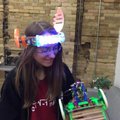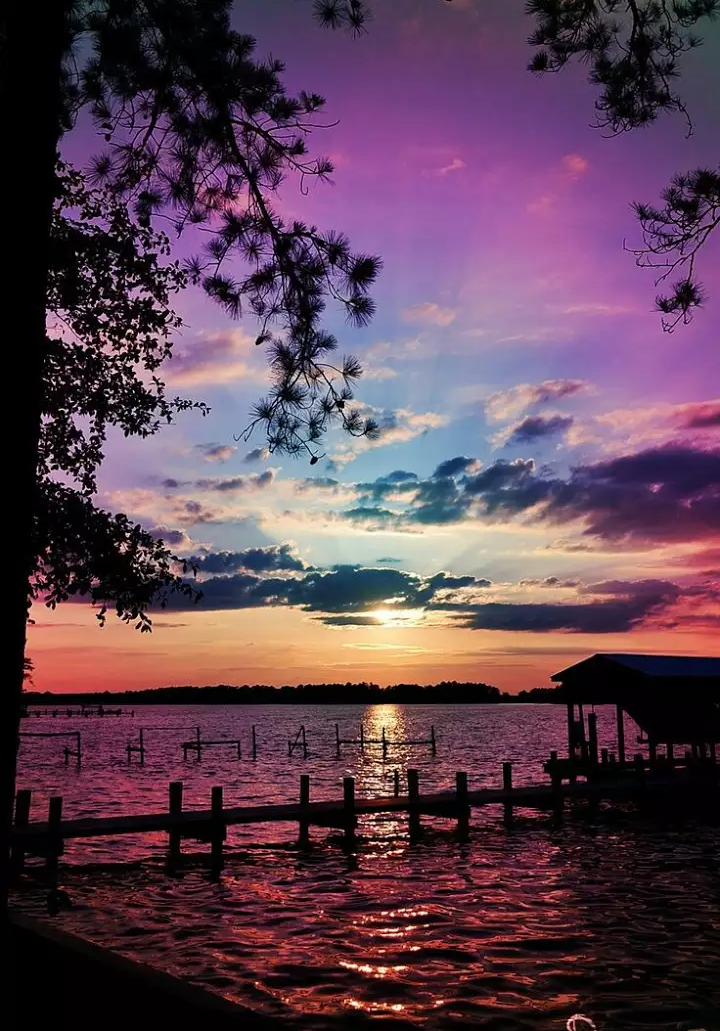The first thing I'd like to do is give an update on the existing Mars rovers (with which I don't have anything to do, sadly for me). Curiosity is doing relatively well, in that they're switching from her B computer back to her A computer to deal with some memory corruption issues (they switched from A to B in 2013). Opportunity is sadly still MIA, although they're still trying to ping her; the dust storm has mostly abated (atmospheric opacity is about 110% of normal).
My device should, if all goes well, go on the Mars 2020 rover. It has been commissioned by Dr. Chris McKay at Ames and I have to go talk to him on the 18th to find out whether I get to build the actual setup that flies to Mars or just tell people how to build it. Either way, I'm going to explain to you today how to make one, which can be done surprisingly cheaply. How's that sound?
 Okay, let's give a big hello to @Matteo Borri! Thanks for joining us on the chat. To get started, why don't you tell us a little about yourself?
Okay, let's give a big hello to @Matteo Borri! Thanks for joining us on the chat. To get started, why don't you tell us a little about yourself?
 I'm from Lombardy (Northern Italy), I tell myself I'm a high-tech artisan, and I take from my grandma in that I'm a bit of a space nut.
I'm from Lombardy (Northern Italy), I tell myself I'm a high-tech artisan, and I take from my grandma in that I'm a bit of a space nut.
 Hah!
Hah!
 So can you start by explaining exactly what it is that you created for the next Mars rover?
So can you start by explaining exactly what it is that you created for the next Mars rover?
 So I've been doing some NASA work for free in order to uphold family honor. The rest of the time I make Android robots, lasers, and various bespoke stuff. I don't have much on hackaday.io but I do have a wiki, most of my work is under creative commons. The exception would be the Battlebots stuff, which is a trade secret (I built the electronics for Bronco).
So I've been doing some NASA work for free in order to uphold family honor. The rest of the time I make Android robots, lasers, and various bespoke stuff. I don't have much on hackaday.io but I do have a wiki, most of my work is under creative commons. The exception would be the Battlebots stuff, which is a trade secret (I built the electronics for Bronco).
 I built a chlorophyll detector. Now that's not too innovative, except that it's solid state (no moving parts) and can operate at some distance from the sample.
I built a chlorophyll detector. Now that's not too innovative, except that it's solid state (no moving parts) and can operate at some distance from the sample.
 This allows it to be mounted on the rover's belly (or on the proximal segment of an existing instrument arm) and scan the ground as it goes.
This allows it to be mounted on the rover's belly (or on the proximal segment of an existing instrument arm) and scan the ground as it goes.
![]() Cool, like for plants?
Cool, like for plants?
 What it can basically do is tell you "no" or "maybe", and once you find a "maybe", that's when you stop and deploy the full spectroscope to get a soil sample. This reduces wear and tear on the main instrument.
What it can basically do is tell you "no" or "maybe", and once you find a "maybe", that's when you stop and deploy the full spectroscope to get a soil sample. This reduces wear and tear on the main instrument.
 Yes, exactly. It also picks up a known false positive, that being green fluorescent markers.... but if we find one of those on Mars it's also big news :)
Yes, exactly. It also picks up a known false positive, that being green fluorescent markers.... but if we find one of those on Mars it's also big news :)
 Essentially it's a specialized spectroscope.
Essentially it's a specialized spectroscope.
 I saw a documentary that mentioned this as a possibility. Its actually happening. :-D
I saw a documentary that mentioned this as a possibility. Its actually happening. :-D
 So it uses a laser?
So it uses a laser?
 pew pew pew
pew pew pew
 Yes and if people want I'll tell you how to build one! Just don't become my competitor please, because I sell them. All my stuff is released under creative commons attribution noncommercial sharealike, so you can make one for fun or for learning, just don't sell em on ebay.
Yes and if people want I'll tell you how to build one! Just don't become my competitor please, because I sell them. All my stuff is released under creative commons attribution noncommercial sharealike, so you can make one for fun or for learning, just don't sell em on ebay.
 It uses a 405nm laser. You can also use a 455nm laser (they are easier to find) but it'll be less responsive.
It uses a 405nm laser. You can also use a 455nm laser (they are easier to find) but it'll be less responsive.
 That's awesome! We have a few community questions we can dive into now, and let the rest of the chat emerge. Our first question is from @Erin RobotGrrl : What redundancy systems did you have to add to your design for sending an instrument to mars?
That's awesome! We have a few community questions we can dive into now, and let the rest of the chat emerge. Our first question is from @Erin RobotGrrl : What redundancy systems did you have to add to your design for sending an instrument to mars?
 Just found this [1]. Interesting interview and nice story
Just found this [1]. Interesting interview and nice story
[1] http://www.mondo2000.com/2018/07/03/matteo-borri-life-on-mars/
 You can get one on Amazon or Ebay but be sure to specify the frequency! The beam should look purple. Note that this sort of thing WILL destroy your eyeballs if they are hit directly, so be safe!
You can get one on Amazon or Ebay but be sure to specify the frequency! The beam should look purple. Note that this sort of thing WILL destroy your eyeballs if they are hit directly, so be safe!
 There's no redundancy at all. We're just going to send two.
There's no redundancy at all. We're just going to send two.
 The system is very simple, fortunately.
The system is very simple, fortunately.
 Is the idea to see what is reflected? What is the detector?
Is the idea to see what is reflected? What is the detector?
 sending two sounds like redundancy to me :p
sending two sounds like redundancy to me :p
 Ah neat! Sending two is redundant, so that's good :)
Ah neat! Sending two is redundant, so that's good :)
 It's a bit of a power hog, but it's light & has no moving part, so sending two complete unit will be easiest, really. The original idea was to do stereo vision when both are working, but I don't think we will implement that in time.
It's a bit of a power hog, but it's light & has no moving part, so sending two complete unit will be easiest, really. The original idea was to do stereo vision when both are working, but I don't think we will implement that in time.
 The detector, surprisingly enough, is a regular camera! Well almost, it's an IR camera with some mods.
The detector, surprisingly enough, is a regular camera! Well almost, it's an IR camera with some mods.
 I can tell you how to make one that is almost as good, if you like.
I can tell you how to make one that is almost as good, if you like.
 Only if they are different, redundancy needs two different systems doing the same job as reference. ;-)
Only if they are different, redundancy needs two different systems doing the same job as reference. ;-)
 Sure, tell us how to make one!
Sure, tell us how to make one!
 You'll need a 405nm laser from Amazon, an older Android phone (not too old though but anything running android 4 should d fine) and some theatre light gels.
You'll need a 405nm laser from Amazon, an older Android phone (not too old though but anything running android 4 should d fine) and some theatre light gels.
 /me plays the McGyver theme
/me plays the McGyver theme
 HAH!
HAH!
 hey this is hackaday :)
hey this is hackaday :)
 I could be playing the Pat&Mat theme
I could be playing the Pat&Mat theme
 Optionally, you can use the "minimodem" circuit and a couple extra parts to trip the laser using the audio port, or you can just turn the laser on and off by hand.
Optionally, you can use the "minimodem" circuit and a couple extra parts to trip the laser using the audio port, or you can just turn the laser on and off by hand.
 So, chlorophyll fluoresces in the near infrared (~700nm) if you hit it with near ultraviolet (~380nm).
So, chlorophyll fluoresces in the near infrared (~700nm) if you hit it with near ultraviolet (~380nm).
![]() Is this the first time that mars has been searched for chlorophyll?
Is this the first time that mars has been searched for chlorophyll?
![]() this also doubles as a cat toy
this also doubles as a cat toy
 Oh cool. :-D
Oh cool. :-D
 Yes, it's the first time we search for chlorophyll directly!
Yes, it's the first time we search for chlorophyll directly!
 at what frequency do cats fluoresce?
at what frequency do cats fluoresce?
 lol
lol
 Heh
Heh
 As with everything else regarding cats: At whatever they feel like at the moment. Cats are gods.
As with everything else regarding cats: At whatever they feel like at the moment. Cats are gods.
 neat, i was wondering how ir came into it, if you were using a uv laser. So the gel acts as a bandpass filter?
neat, i was wondering how ir came into it, if you were using a uv laser. So the gel acts as a bandpass filter?
 Exactly.
Exactly.
 Turns out that chlorophyll fluorescence is actually a gaussian curve (like most things in nature) so there's a bit of a fudge factor in the wavelength.
Turns out that chlorophyll fluorescence is actually a gaussian curve (like most things in nature) so there's a bit of a fudge factor in the wavelength.
 This is great because it lets us use regular cameras, and regular lasers (UV lasers are expensive, and most importantly, fragile!)
This is great because it lets us use regular cameras, and regular lasers (UV lasers are expensive, and most importantly, fragile!)
 Diode lasers are pretty tough, all you have to do is make sure they don't avalanche. In our case we're just limiting the current to drive the diode at about 70% of its max output, so we have a bit of safety factor.
Diode lasers are pretty tough, all you have to do is make sure they don't avalanche. In our case we're just limiting the current to drive the diode at about 70% of its max output, so we have a bit of safety factor.
 So, for the bandpass filter....
So, for the bandpass filter....
 Half of it is primary red. Nothing strange about that; you want to filter out the laser you're emitting.
Half of it is primary red. Nothing strange about that; you want to filter out the laser you're emitting.
 The other half is congo blue. You have to specifically buy "congo blue" filters.
The other half is congo blue. You have to specifically buy "congo blue" filters.
 The reason for this is that they let through IR!
The reason for this is that they let through IR!
 So, two layers of each (RBRB) in front of your phone camera will block out all except near IR, basically.
So, two layers of each (RBRB) in front of your phone camera will block out all except near IR, basically.
 On Earth, you can take this out on a sunny day and take some pretty cool "false color" pictures....
On Earth, you can take this out on a sunny day and take some pretty cool "false color" pictures....
 you can even do this to welding goggles (remove the usual welding glass first of course) and go outside in the sun after letting your pupils expand. DO NOT LOOK UP AT THE SUN obviously. But look at plants etc.
you can even do this to welding goggles (remove the usual welding glass first of course) and go outside in the sun after letting your pupils expand. DO NOT LOOK UP AT THE SUN obviously. But look at plants etc.
 I have some videos on youtube showing this, is it OK if I post a link to my channel?
I have some videos on youtube showing this, is it OK if I post a link to my channel?
![]() You should regardless.
You should regardless.
 Please do!
Please do!
 I want to see these!
I want to see these!
 https://www.youtube.com/channel/UCwfCldqmzcFZkjjnZi_IHAw?view_as=subscriber Here ya go! I actually show the thing in action. My recent video has nothing to do with it though
https://www.youtube.com/channel/UCwfCldqmzcFZkjjnZi_IHAw?view_as=subscriber Here ya go! I actually show the thing in action. My recent video has nothing to do with it though


 effect would be like that
effect would be like that
 So, if you build this, the first thing you will notice is:
So, if you build this, the first thing you will notice is:
- Plants look orangeish to your eyes and pinkish to the camera (Because your eyes do color correction)
 - Ordinary stuff that is painted green, will look black!
- Ordinary stuff that is painted green, will look black!
 So, this is also how you defeat forest camouflage, if you ever want to.
So, this is also how you defeat forest camouflage, if you ever want to.
 One thing - when you make your RBRB filter, you will probably have to sandwich it between the phone's back cover and the phone.
One thing - when you make your RBRB filter, you will probably have to sandwich it between the phone's back cover and the phone.
 This is because the camera (or your pupils) have to operate in night mode, max aperture/exposure since you're basically throwing away 98% of the light that comes your way!
This is because the camera (or your pupils) have to operate in night mode, max aperture/exposure since you're basically throwing away 98% of the light that comes your way!
 Interesting how it defeats camouflage
Interesting how it defeats camouflage
 Get a leaf, or anything else containing chlorophyll (you can use a lemon for example)
Get a leaf, or anything else containing chlorophyll (you can use a lemon for example)
 so why do you need a camera and not just a point sensor?
so why do you need a camera and not just a point sensor?
 You can use the size of the "dot" to determine density, up to a point.
You can use the size of the "dot" to determine density, up to a point.
![]() Do you have a prediction on the results from mars?
Do you have a prediction on the results from mars?
 Spectro it is a adjustable range on waves , am i correct on that Matteo ?
Spectro it is a adjustable range on waves , am i correct on that Matteo ?
 I found that it's easier to do so with a bunch of relatively good sensors (the camera pixels) than with only one sensor. A bit of image processing later, and you can actually get some quantitative measurements.
I found that it's easier to do so with a bunch of relatively good sensors (the camera pixels) than with only one sensor. A bit of image processing later, and you can actually get some quantitative measurements.
 Yes, you are but this is a specialized tool, it only picks up Chl.
Yes, you are but this is a specialized tool, it only picks up Chl.
 My prediction is that we're going to find a little angry guy with a Roman helmet.
My prediction is that we're going to find a little angry guy with a Roman helmet.
![]() Haha
Haha
![]() Do you know where on mars it will be?
Do you know where on mars it will be?
 With the phone with the filter gels in it, go back indoors (Or go on Mars where the Sun exposure isn't very high) and carry with you a leaf or a bit of lemon or anything like that. Aim the phone at it. You should get black. Now aim the laser at it, and you'll get a red/pink dot! Adjust the laser focus for optimal conditions (don't focus too tight or you'll burn the sample). You can do this with rocks with little bits of moss on it, or even "clean" rocks that happen to have cyanobacteria on them.
With the phone with the filter gels in it, go back indoors (Or go on Mars where the Sun exposure isn't very high) and carry with you a leaf or a bit of lemon or anything like that. Aim the phone at it. You should get black. Now aim the laser at it, and you'll get a red/pink dot! Adjust the laser focus for optimal conditions (don't focus too tight or you'll burn the sample). You can do this with rocks with little bits of moss on it, or even "clean" rocks that happen to have cyanobacteria on them.
 I'm actually not sure where the Mars 2020 rover is scheduled to land
I'm actually not sure where the Mars 2020 rover is scheduled to land
 So cool! That's not too tough to put together
So cool! That's not too tough to put together
 on the sensor on mars do you also use an image sensor, or a photodiode?
on the sensor on mars do you also use an image sensor, or a photodiode?
 Let's hop into a few more community questions. @Richard Hogben asks: Are you given constraints like dimensions/weight before or after the instrument is designed?
Let's hop into a few more community questions. @Richard Hogben asks: Are you given constraints like dimensions/weight before or after the instrument is designed?
 The idea is to use a low res (160x120) image sensor. Part of the reason for this is that if some of the pixels die, we can more or less live with it.
The idea is to use a low res (160x120) image sensor. Part of the reason for this is that if some of the pixels die, we can more or less live with it.
 ahh, makes sense, cheers!
ahh, makes sense, cheers!
 In general there's a hard constraint on mass and dimensions, and within that, you're asked to keep your mass as low as possible.
In general there's a hard constraint on mass and dimensions, and within that, you're asked to keep your mass as low as possible.
 Do you remember what those constraints were, roughly?
Do you remember what those constraints were, roughly?
 50x50x20mm and 120g. Which is really not a lot. Which is why this instrument is interesting at all since comparable tools are more accurate, but a lot bigger!
50x50x20mm and 120g. Which is really not a lot. Which is why this instrument is interesting at all since comparable tools are more accurate, but a lot bigger!
 does that include power?
does that include power?
 https://www.nasa.gov/solve/marsbalancechallenge Basically what happens is that everyone designing a component tries to skimp on mass, and then if there's any left, like there was in this case, there's room for "bonus science".
https://www.nasa.gov/solve/marsbalancechallenge Basically what happens is that everyone designing a component tries to skimp on mass, and then if there's any left, like there was in this case, there's room for "bonus science".
 No, we get power from the main bus. That's actually one thing I am not happy about this design: it's a bit of a power hog.
No, we get power from the main bus. That's actually one thing I am not happy about this design: it's a bit of a power hog.
 Since the 2020 rover is nuclear powered like Curiosity, it's less of a worry.
Since the 2020 rover is nuclear powered like Curiosity, it's less of a worry.
 cool, what kind of nuclear power?
cool, what kind of nuclear power?
 RTG/..
RTG/..
 A radiothermal generator. Basically the same as the one you see in The Martian.
A radiothermal generator. Basically the same as the one you see in The Martian.
 ah gotcha
ah gotcha
 do you do any kind of calibration with your sensor btw?
do you do any kind of calibration with your sensor btw?
 You get 110W out of it... and a whole lot of heat which is a mixed blessing... and a bunch of radio noise! In fact the most likely cause of a dead pixel in a mars rover camera (including my sensor) is the RTG itself.
You get 110W out of it... and a whole lot of heat which is a mixed blessing... and a bunch of radio noise! In fact the most likely cause of a dead pixel in a mars rover camera (including my sensor) is the RTG itself.
 ooh thats interesting re. radio noise
ooh thats interesting re. radio noise
 Yes, the idea is to build the final version of it and then shoot water with various Chl concentrations with it.
Yes, the idea is to build the final version of it and then shoot water with various Chl concentrations with it.
 ahh, sweet
ahh, sweet
 I guess shielding would be heavy...
I guess shielding would be heavy...
 The main point of my sensor is to find, as the rover trundles on, spots where it's worth it to deploy the main spectrometer.
The main point of my sensor is to find, as the rover trundles on, spots where it's worth it to deploy the main spectrometer.
 how does the main spectrometer, work, is that like a ramen spectrometer or something?
how does the main spectrometer, work, is that like a ramen spectrometer or something?
 *raman even
*raman even
 Yes, it's a Raman spectrometer. And now I'm hungry.
Yes, it's a Raman spectrometer. And now I'm hungry.
![]() What is the sensing distance of your instrument?
What is the sensing distance of your instrument?
 Since that one has a lot of moving parts, and mine doesn't, mine can be turned on and off at will whereas the main instrument has a risk of seizing up etc.
Since that one has a lot of moving parts, and mine doesn't, mine can be turned on and off at will whereas the main instrument has a risk of seizing up etc.
 If you're just trying to pick up a leaf, about half a meter
If you're just trying to pick up a leaf, about half a meter

Discussions
 Stephen Tranovich
Stephen Tranovich